Kami Kamashiki and Kaishi
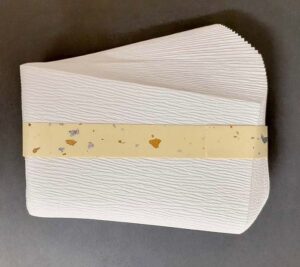
The kami kama-shiki, 紙釜敷, paper kettle-place, is a folded pack of papers that provides a place for the kama, 釜, kettle, when it is removed from the hearth. In Chanoyu, the hearth refers to the portable fu-ro, 風炉, wind-hearth, and the sunken ro, 炉, hearth, set in the floor.
The kami kamashiki varies in number of sheets of paper, size, color, design, quality, etc. The choice of Sen no Rikyū is plain white mi-no gami, 美濃紙, beauty-thick paper, 8.8 x 6 sun kujira-jaku, and has twenty sheets of paper. The number 8 eight, in Japanese is hachi, 八, is symbolic of Infinity in Space and the auspicious sue-hiro, 末広, ends-wide. The Kanji is one/eighth of a circle. The number 6 six, in Japanese is roku, 六, is symbolic of Infinity in Time.
Because the kami kamashiki is, at times, displayed in the tokonoma, kazari, 飾, display, decorative and lavish paper kamashiki, are available, and are not used to support the kama. The paper of the kami kamashiki, pictured above, is called dan-shi, 檀紙, sandalwood-paper; its ridged surface is likened to the bark of the sandalwood tree. The paper band is to keep the pack of papers together until it is displayed.
The fanning aspect of the multiple sheets of paper makes the kami kamashiki a visual example of sue-hiro, 末広, ends-wide, which is symbolic of Infinity in Space. This is found in the Japanese Kanji for the number eight, hachi, 八.
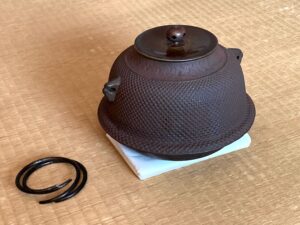
The kama, 釜, kettle, is ‘shin-nari’, 真形, true-form, with curved flange, hane, 羽, wing, tetsu, 鉄, iron, surface pattern of arare, 霰, hailstone, ki-men kan-tsuki, 鬼面鐶付, metal ring-attach. Kama no futa, 窯の蓋, kettle’s lid, Kara-kane, 唐銅, Tang-copper, bronze: the spherical knob, tsumami, 摘, pinch, is in the form of ume no hana, 梅の花, ‘plum’s flower. The hane of the kama rests on the upright collar, koshiki, 甑, (rice) steamer, of a furo.
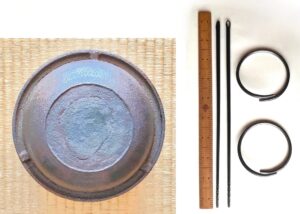
Pictured above, is the exterior bottom, soko, 底, of a kama, 釜, kettle, used with the fu-ro, 風炉, wind-hearth, tetsu, 鉄, iron. The diameter of the inner ring is 3.8 sun kane-jaku. The diameter of the vessel without the flange, hane, 羽, wing, is 6 sun kane-jaku. The full diameter including the hane is 7 sun kane-jaku. Note the three bosses, katamari, 塊, lump, inside the hane that raise the kama above the supporting furo collar, koshiki, 甑, (rice) steamer. The bosses act as a mini tripod. The kettle’s shō-men, 正面, correct-face, is made up of the two bosses: the single boss is located at the back when placed on the furo. This placement reflects the location of the tsume, 爪, talons, of a trivet-like go-toku, 五徳, five-virtues, that would support a kama in a furo without a koshiki.
The bamboo ruler is called a kane-jaku, 曲尺, bend-span; the length is just short of twelve inches, or 30.3cm.
Hi-bashi, 火箸, fire-rods, with eyelets, hollow, blackened steel; L. 9.5 sun kane-jaku. The hibashi are like the number 8 in Japanese, hachi, 八, which is a counterpart to the Western concept of the number 8 on its side, ∞, called by mathematician Wallis, a lemniscate, and in Western culture has come to represent Infinity in Time. The design is based on the celestial movement of the planet Jupiter according to some scholars.
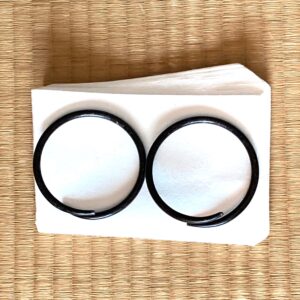
The diameter of each one of the pair of kan, 鐶, metal ring, is 2.75 sun kane-jaku. The two kan placed side by side have a measurement of 5.5 sun kane-jaku, which is the width of the kami kama-shiki, 紙釜敷, paper kettle-spread. The length of the straightened kan is approximately 9.3 sun kane-jaku.
Kan, 鐶, metal rings, blackened steel with a diameter of 2.75 sun kane-jaku, if straightened, the length is approximately 9.5 sun kane-jaku. The number 9.5 in Japanese can be read kyū-go, which is wordplay on kyū-go, 救護, salvation-protect. The kan are emblems of a circle which is symbolic of Infinity in Time. The hibashi, when used, fan outward, which is a prime example of suehiro, and Infinity in Space. Because the kan have open ends, this makes them manifest in both receptive and penetrative aspects, In and Yō, 陰 and 陽.
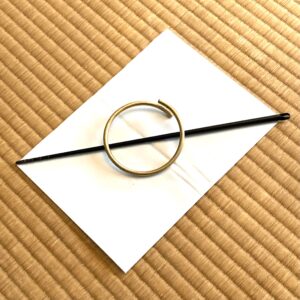
Kan made of brass are the standard by which most kan are created which may or may not be followed by other artists. They are rarely seen by the guests, as they are used primarily relegated to the mizuya. These kan have a diameter of 2.8 sun kujira-jaku. If straightened, they have a length of 9.3 sun kane-jaku. This measurement is equal to the diagonal length of a sheet of kami kamashiki folded only one time.
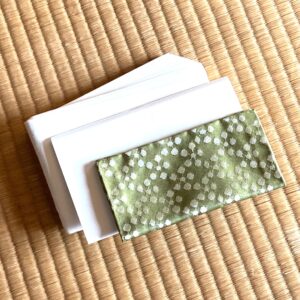
The kami kamashiki is the same pack of papers used with the portable fu-ro, 風炉, wind-hearth, and the sunken ro, 炉, hearth. The utensils are shown as they would be placed in the futokoro, with the kami-kamashiki nearest the body. Note that the fukusa is not included, as the fukusa would be held in the obi of the host, tei-shu, 亭主, house-master, ready for use.
The number of sheets of paper for the kami kamashiki varies from 20 to 48 sheets of paper. The sheaf is folded in half twice, in opposite directions, to form a rectangle. The paper that Rikyū preferred is plain white Mi-no gami, 美濃紙, Beauty-thick paper, from the Mino area which has been noted for its paper-making since ancient times.
When building the charcoal fire, sumi-bi, 炭火, the teishu usually places a pack of kami kamashiki in the front of the kimono called the futokoro, 懐, which is also read kai. There are times when the kami kamashiki is placed on the sumi-tori, 炭斗, charcoal-measure, and carried into the room. The kami kamashiki is placed in the futokoro only when required for use to support the kama.
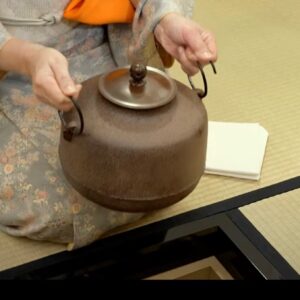
During the charcoal procedure, in preparing to remove the kama from the hearth, the kami kamashiki is taken from the kimono futokoro and placed on the floor adjacent to the hearth. The kama is removed from the hearth and rested on the kami kamashiki. The image above illustrates this movement in ro season.
The kama on the kami kamashiki may be slid away from the hearth. After the charcoal is put into the hearth, incense is put into the fire in the hearth. The kama is returned to the hearth, and the kami kamashiki is slipped back into the kimono futokoro, or placed on the sumi-tori, 炭斗, charcoal-measure. The kami kamashiki is taken from the kimono once the teishu leaves the Tearoom and reenters the preparation room, mizu-ya, 水屋, water-house. The kō-gō, 香合, incense-gather, the incense container, is offered to the guests so that they may examine it more closely, hai-ken, 拝見, respect-see.
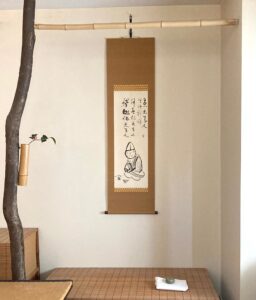
Garandō tokonoma; kake-jiku, 掛軸, hang-scroll, image of Rikyū and calligraphy by Sen-gai Gi-bon, 仙厓義梵, Hermit-shore Righteous-buddha, bamboo kake hana-ire, 掛花入, hang flower-receptacle, and bamboo kō-gō, 香合, incense-gather, on a pack of kami kama-shiki, 紙釜敷, paper kettle-spread.
Quite often, during some Tea gatherings, the charcoal fire is attended to without the formal procedure in the presence of the guests. Because of the importance of incense at a Tea gathering, the kōgō is displayed in the tokonoma, and most often is supported on a pack of kami kamashiki. It is the custom to display a pack of kami kamashiki that is made of fine, even exquisite paper, color, and design, rather than the kami kamashiki used to support the kettle, which could damage the paper.
Rikyū put byaku-dan, 白檀, white-sandalwood, into the furo, and in neri-kō, 練香, kneaded-incense, in the ro. Nerikō is a blend of aromatics mixed with charcoal dust, and is moist.
The kami kamashiki is placed on the floor of the tokonoma, the secondary V-fold is directed toward the toko-bashira, 床柱, floor-post. This is true in a tokonoma that is kami-za, 上座, upper-seat. The tokobashira is on the left side of the tokonoma, whereas in a ge-za doko, 下座床, down-seat floor, the tokobashira is on the right side of the tokonoma. In a geza doko, the V-fold of the kami kamashiki is directed to the tokobashira to the right.
When the kami kamashiki is used with the portable fu-ro, wind-hearth, the V-fold is directed toward the fire, just as when using the sunken hearth, ro, the V-fold is directed toward the fire, no matter where the ro is located in the Tea room.
When the kami kamashiki is held in the kimono futokoro during the ro season, the side of the pack with many layers of paper is facing out of the kimono opening. This many layers is called awase, just like wearing several lined awase kimono in the cold weather. When using the furo, the simple V-fold of the kami kamashiki is in the futokoro facing out of the kimono opening. This, like the kimono is a single layer, or hitoe, 単. The kami kamashiki, like the kaishi, kobukusa, and fukusa, are partially visible in women’s kimono, whereas the same things are hidden completely in men’s kimono. This is an aspect of In and Yō, 陰 and 陽, Yin and Yang, visible and hidden.
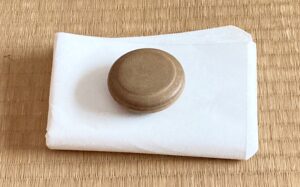
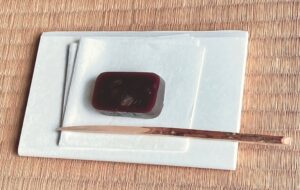
Kō-gō, 香合, incense-gather, covered container made of two take fushi, 竹節, bamboo nodes; diam. 2.2 sun kane-jaku. Three squares of byaku-dan, 白檀, white-sandalwood, that are to be burned in a fu-ro, 風炉, wind-hearth, are held in the kōgō. The kōgō is displayed on a pack of kami kama–shiki, 紙釜敷, paper kettle-spread, and shown as it would be displayed in the tokonoma.
The pictured o-ka-shi, お菓子, hon.-sweet-of, is a block of neri yō-kan, 煉羊羹, knead sheep-stew, made of red beans, sugar, and agar. The sweet is placed on a folded pack of kai-shi, 懐紙, heart-paper.
It should be remembered that the kami kamashiki was the original kai-shi, 懐紙, heart-paper. There is an important homonym for kai-shi, 懐紙, heart-paper. In Buddhism, especially Jō-do, 浄土, Pure-land, kai-shi, 戒師, precept-master, refers to a teacher who bestows the essential precepts of the faith. Essential to Buddhism are the San-kai, 三戒, Three-precepts. Shin Ku I, 身口意, Body Mouth Mind; the three actions of body, speech, and mind. To be modest in body, to be modest in speech, and to purify one’s mind. Additional precepts also include the go-kai, 五戒, five-precepts, which are: prohibitions against killing, theft, sexual misconduct, lying, and intoxication. One of the measurements of the kami kamashiki is 5.5 sun kane-jaku.
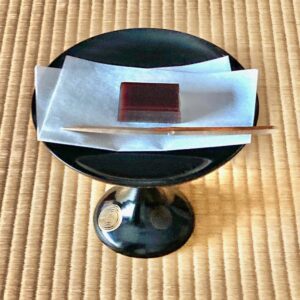
O-ka-shi, お菓子, hon.-sweet-of, yō-kan, 羊羹, sheep-stew, red bean gel block displayed on two folded sheets of kai-shi, 懐紙, heart-paper, offered on a taka-tsuki, 高杯, tall-cup, together with a single pick of kuro-mo-ji, 黒文字, black-letter-character; L. 6 sun kane-jaku. The turned wood, black-lacquered wood takatsuki height is 5.2 sun kane-jaku. Lacquer artists use the kujira-jaku for measurements so that the ‘correct’ height is 4.16 sun kujira-jaku, 4 x 4=16. The diameter of the tray is 5.2 sun kujira-jaku. It is curious that the height is 5.2 sun kane-jaku, and the diameter is 5.2 sun kujira-jaku. These numbers enhance the relationship between the two different shaku lengths – kane-jaku and kujira-jaku, which relate to each other 8:10. The diameter of the foot is 2.7 sun kujira-jaku, or 3.375 sun kane-jaku. The number 33 may evoke the 33 different manifestations of Kannon.
This style of presentation of sweets in Chanoyu is for offerings to a ki-nin, 貴人, nobility-person, or deity. The kinin takes the kuromoji, places it on his or her own kaishi on the floor, then takes the sweet with the kaishi. After eating the sweet, the kuromoji is kept as a souvenir. As a remembrance, each guest takes the kuromoji pick that was offered to the guest when the sweet was served.
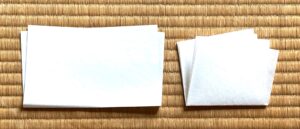
Excessively wet okashi can soak through several sheets of kaishi, so that one may take a sheet of kaishi and fold it twice in opposing directions. This creates four levels of paper, which resembles the folded kami kama-shiki. There are also waterproof papers and small thin wood sheets that help cope with the wetness of some sweets. The original intent of folding the paper is to keep the sheaf of papers together.
Kō-gō, 香合, incense-gather, ceramic, covered container in the form of seated Ho-tei, 布袋, cloth-bag. Displayed on a pack of kami kama–shiki, 紙釜敷, paper kettle-spread. The ceramic kōgō holds neri-kō, 練香, knead-incense, to be burned in the ro.
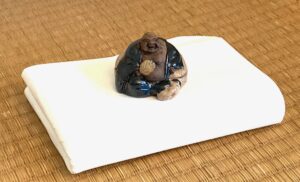
Hotei is a much loved deity who grants wishes and wealth, and is believed to be an incarnation of Mi-roku Bo-satsu, 弥勒菩薩, Increase-rein Grass-buddha, the Buddha to come. Worship of Hotei includes recitation of the Heart Sutra.
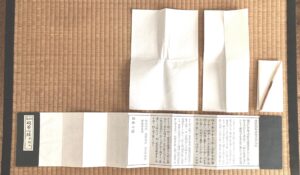
Three sheets of the kami kama-shiki, 紙釜敷, paper kettle-spread, to show that folding a sheet of kami kamashiki in the manner of folding a chakin, creates a simile to the abbreviated Japanese version of the Heart Sutra, Ma-ka-han-nya-shin-gyō, 摩訶般若心経, Polish-scold-carry-young-heart-sutra. A more elaborate version of the Heart Sutra is printed on the verso of the booklet. The length of the kuro-mo-ji, 黒文字, black-lettler-character, pick is 6 sun kane-jaku, which is the same measurement of the diagonal span of the Heart Sutra booklet, and thus creates an association with the kaishi used in the Tearoom to eat the sweet.
It is likely that the form of the kami-kamashiki is an adaptation of the standard folded paper Heart Sutra. Were a sheet of kami kamashiki cut in half, and placed side by side, the pieces would be equal to the size of the six panels of the Heart Sutra.It is no coincidence that the kami kamashiki and the booklet of the Heart Sutra are kept in the kimono near the heart, futokoro/kai, 懐. The Kanji for futokoro is composed of kokoro, shin, 心, heart, and futokoro, 褱, to carry in the kimono front.
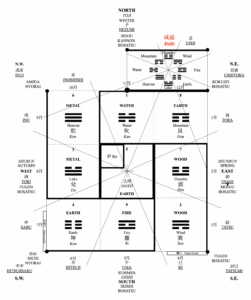
Diagram of the yo-jō-han, 四畳半, four-mat-half, with directions, lunar months, five elements, Buddhist deities, Asian zodiac signs, trigrams from the Ekikyō/I Ching, etc. The tokonoma has its own arrangements of signs. The kō-gō, 香合, incense-gather, and the kami kama-shiki, 紙釜敷, paper kettle-spread, are placed on the East side of the tokonoma, at the trigram, ☲, Ri, 離, Detach, symbolic of Fire. This is the location for placing a candlestick.
The signs of the Ekikyō/I Ching identified with the yojōhan, influence the tokonoma. The Northeast has the influence of the trigram, ☶, Gon, 艮, Stop, symbolic of Mountain.
The hana-ire, 花入, flower-receptacle, full of water is placed in the middle of the Water area marked with the trigram, ☵, Kan, hole, area of the tokonoma, or directly in the middle of the tokonoma when displaying a horizontal scroll. The kōgō on the kami kamashiki, is placed on the right side of the tokonoma, marked with fire, ☲, Ri, 離, detach. However, traditionally, the kōgō is placed a little closer to the front of the tokonoma as though it intended to include the sign of Earth, ☷, Kon, 坤, land.
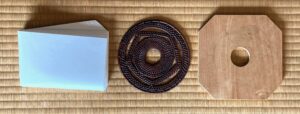
Three kama-shiki, 釜敷, kettle-spread: L. kami, 紙, paper, W. 5.5 sun kane-jaku; kumi, 組, braid, tō, 籐, rattan, diam. 5 sun kane-jaku; ita, 板, board, sugi, 杉, cedar, greatest width, 6.5 sun kane-jaku.
Following Urasenke tradition, the kami kamashiki is used during sho-zumi, 初炭, first-charcoal. The kumi kamashiki is used during go-zumi, 後炭, latter-charcoal, carried in the charcoal basket, may be presented after koicha and before usucha. The ita kamashiki is regarded as a work utensil, and rarely seen by the guests.

Kama, 釜, kettle, for sunken ro, 炉, hearth, with concave shoulder and mouth in the form called ‘ya-hazu’, 矢筈, arrow-nock, tetsu, 鉄, iron, with rounded bottom, soko, 底, widest diameter 8.2 x approximately 5.3 sun kane-jaku, with Kara-kane futa, 唐銅蓋, Tang-copper lid; diam. 4 sun kane-jaku; by Kawa-be Ken-ichi, 川邊憲一, River-side Law-one, Kashi-hara, 橿原, Oak-plain, Na-ra, 奈良, What-good. The kama is seated on a kami kama-shiki, 紙釜敷, paper kettle-spread.

The pack of kami kama-shiki, 紙釜敷, paper kettle-spread, consists of twenty sheets of paper. The pack is folded in half two times in opposite directions, so that there are 80 layers of paper. The number 8, hachi, 八, is symbolic of Infinity in Space. The folded pack is in the form of the Japanese Kanji for eight, hachi, 八. The two numbers together create the number, 88, 八十八, hachi-jū-hachi, which is highly symbolic of Infinity in Space. The number 八十八 can be written to form the Kanji for kome, 米, rice. This Kanji becomes the center of Infinity.
To further the identification of 88 and the kami kamashiki, the ita kamashiki is a square board with mitered corners, so that it has eight sides, it becomes an octagon and the center of Infinity. Both kamashiki are made of wood, and adding the grass radical for plant, 艹, creates the Kanji for tea, cha, 茶. The Kanji, 茶, is also a number – 108, hyaku-hachi bon-nō, 百八煩悩, hundred-eight anxiety-trouble, the number of human afflictions that must be overcome to attain enlightenment.

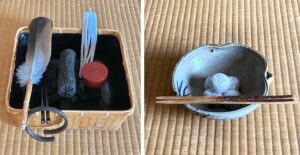
In Chanoyu, a charcoal fire is made in the portable fu-ro, 風炉, wind-hearth, in the warm part of the year, and in the sunken ro, 炉, hearth, in the cold part. When the fire is built in the company of guests, charcoal is brought into the room in a sumi-tori, 炭斗, charcoal-measure; 8 x 8 sun kane-jaku. Rikyū chose a basket for furo, and a gourd for ro. Various utensils including metal hi-bashi, 火箸, fire-rods, and a kō-gō, 香合, incense-gather, are held in the container.
Aside from heating water for tea, the hearth is also a kō-ro, 香炉, incense-hearth, to fill the air with fragrance of Buddhism. When using the furo, three small squares of byaku-dan, 白檀, white-sandalwood, are held in the kōgō, and two pieces are put into the fire. One piece is left in kōgō, for the guests to examine when looking at the container. When the charcoal fire is not built in the company of the guest, the kōgō is displayed in the tokonoma, placed on the pack of paper of the kami kama-shi, 紙釜敷, paper-kettle-spread.
O-ka-shi, お菓子, hon.-sweet-of, is served before drinking 濃茶, thick-tea, and, there are countless varieties. Ideally, the teishu makes the sweet just prior to the Tea gathering. A very popular sweet is mochi with red bean filling. For several guests, the sweets may be served in a ka-shi-bachi, 菓子鉢, sweet-of-bowl. Pictured above is bowl of Shiga-raki yaki, 信楽焼, Faith-pleasure fired, stoneware with kata-kuchi, 片口, side-mouth, gray slip and black and blue brush pattern of sasa, 笹, bamboo grass; diam. 6 sun kane-jaku. Pair of hashi, 箸, rods, kuro-mo-ji, 黒文字, black-letter-character, spicebush, L. 8 sun kane-jaku. sue-hiro, 末広, ends-wide. In Japanese tradition, the number six, roku, 六, is symbolic of Infinity in Time, and the number eight, hachi, 八, is symbolic of Infinity in Space.

Sumi, 炭, charcoal; shin sumi, 真炭, true charcoal, is comprised of black dō-zumi, 胴炭, body-charcoal, gi-tchō, 毬杖, ball-stick, wari-gitchō, 割毬杖, divided ball-stick, kuda-zumi, 管炭, cylindrical-charcoal, ten-zumi, 点炭, offer-charcoal, and three white eda-zumi, 枝炭, branch-charcoal. Together with a pair of kan, 鐶, metal rings, and a pack of kami kama-shiki, 紙釜敷, paper kettle spread. The sumi-tori, 炭斗, charcoal-measure, wood box, 7 sun kane-jaku square. There are larger boxes for ro sumi of plain wood, the choice of Rikyū, and there are the same size boxes covered with black lacquer that were the choice of Sōtan, Rikyū’s grandson. Different Tea masters have created many various styles of sumitori.
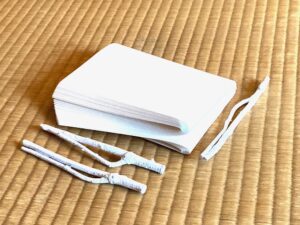
Kami kama-shiki, 紙釜敷, paper kettle-spread, pack of papers folded twice in opposite directions, with three pieces of eda-zumi, 枝炭, branch-charcoal. Edazumi length is 5 sun kane-jaku, for fu-ro, 風炉, wind-hearth.
When using the furo to heat water for tea, three pieces of edazumi are carried in the sumitori, however, only two pieces are put into the fire. One piece of edazumi is left in the sumitori. It is interesting to compare the paper folds of the paper and the bifurcation of the edazumi. The form of the fold and the branch charcoal resemble the Japanese number 8, hachi, 八, which is symbolic of Infinity in Space. Hachi hachi, 八八, is symbolic of greater Infinity.
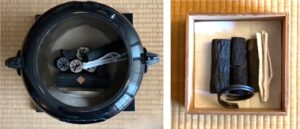
Left: the fu-ro, 風炉, wind-hearth, Kara-kane, 唐銅, Tang-copper, bronze; opening diameter is 7 sun kane-jaku.
Right: sumi-tori, 炭斗, charcoal-measure, kami-o-shiki, 神折敷, god-fold-spread, cedar; 7 x 7 sun kane-jaku. A circle is In, 陰, Yin, negative, a square is Yō, 陽, Yang, positive. Note the locations of the mae-kawarake, 前瓦, fore-tile, in the furo, (shallow crescent in front of the charcoal with the square of byakudan), and the pair of kan, 鐶, metal rings, in the sumitori.
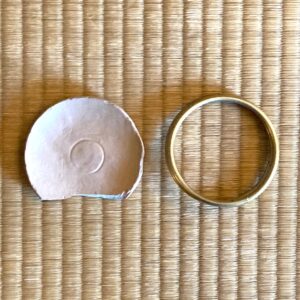
Sakazuki, 盃, sake cup, pottery, for drinking o-mi-ki, お神酒, hon.-god-alcohol (sake), from I-se Jin-gū, 伊勢神宮, That-strength God-palace, used as mae-kawarake, 前土器, fore-earth-container, in fu-ro, 風炉, wind-hearth, to deflect heat; diam. 2.8 sun kujira-jaku. Manifests receptive, In, 陰, Yin, principle.
Pair of kan, 鐶, metal rings, shin-chū, 真鍮, true-brass, used to transport a kama, 釜, kettle; diam. 2.8 sun kujira-jaku. Manifests penetrative, Yō, 陽, Yang, principle. Gautama is the 28th in the lineage of Buddhas.

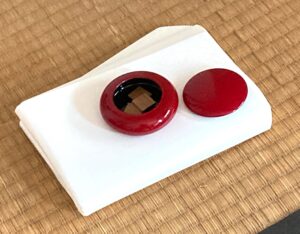
Left: kō-gō, 香合, incense-gather, lacquered wood in the shape of an oshidori, 鴛, mandarin duck; L. 3.6 sun kane-jaku, China. Shown with a square chip of byaku-dan, 白檀, white-sandalwood, as it would be offered to the guest to examine. The color red dispels evil spirits.
Right: kō-gō, 香合, incense-gather, round, covered container with rich red lacquer, Viet Nam; diam. 2 sun kane. The kōgō as it would be displayed on a pack of kami kamashiki in the tokonoma. The kōgō is usually closed when displayed in the tokonoma. The guest may handle the kōgō only upon the invitation of the host.

